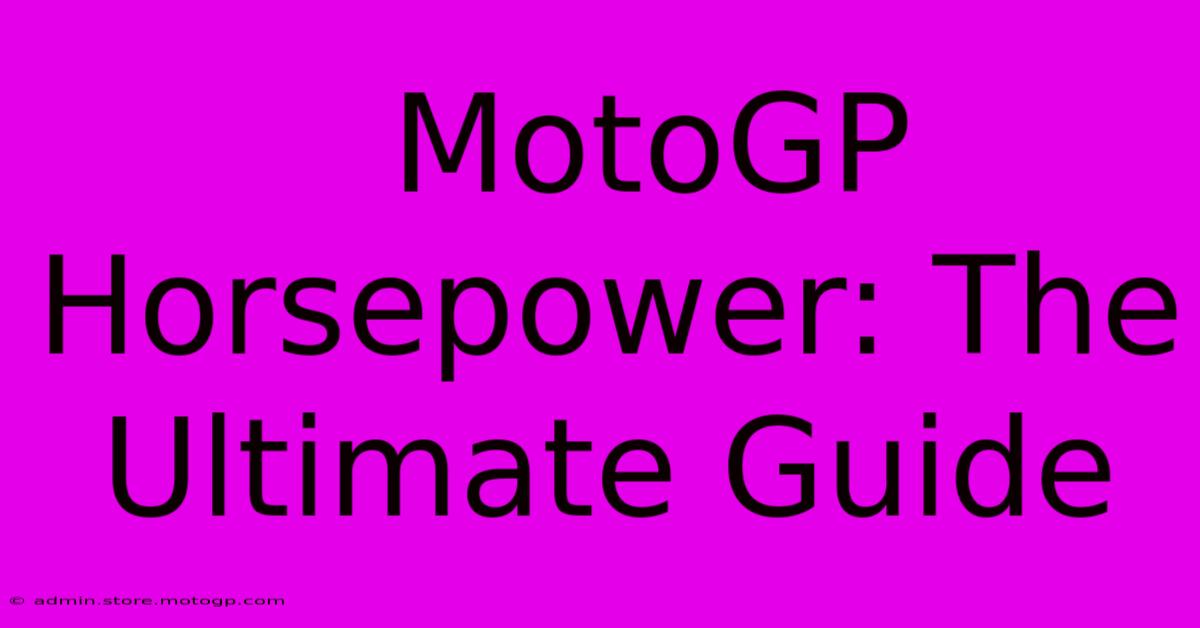MotoGP Horsepower: The Ultimate Guide

Table of Contents
MotoGP Horsepower: The Ultimate Guide
MotoGP. The pinnacle of motorcycle racing. The roar of the engines, the breathtaking speeds, the nail-biting finishes – it's all fueled by incredible horsepower. But just how much horsepower are we talking about? And what factors contribute to these phenomenal power figures? This ultimate guide dives deep into the world of MotoGP horsepower, exploring the technology, regulations, and the relentless pursuit of speed.
Decoding MotoGP Power: More Than Just Horsepower
While the exact horsepower figures remain closely guarded secrets by the manufacturers, it's widely accepted that MotoGP bikes produce over 260bhp. However, it's crucial to understand that this number is highly contextual. It's not a static figure; it varies based on several factors:
-
Engine Configuration: MotoGP bikes utilize sophisticated inline four-cylinder engines, meticulously engineered for optimal power delivery throughout the rev range. The precise configuration – bore, stroke, valve timing – is constantly tweaked for performance gains.
-
Track Conditions: Temperature, humidity, and altitude significantly impact engine performance. Teams constantly monitor and adjust engine settings to maximize power output under varying conditions.
-
Fuel and Electronics: The type of fuel used, and the sophisticated electronic control systems (engine control units or ECUs) play a pivotal role in fine-tuning power delivery. These systems manage fuel injection, ignition timing, and other critical parameters.
-
Aerodynamics: The aerodynamic design of the bike is crucial. Efficient aerodynamics reduce drag, allowing the engine's power to translate directly into speed.
The Quest for More: Technological Advancements
The relentless pursuit of higher horsepower drives constant innovation in MotoGP. Engineers are continuously exploring new technologies to eke out even marginal gains:
-
Improved Materials: Lighter, stronger materials allow for increased engine speeds and higher power output without compromising reliability.
-
Sophisticated Engine Management Systems: The ECUs manage a complex interplay of systems, optimizing power delivery while managing engine temperature and fuel consumption.
-
Aerodynamic Refinements: Wind tunnel testing and computational fluid dynamics (CFD) are used to minimize drag and maximize downforce, improving cornering speeds and overall performance.
The Importance of Power-to-Weight Ratio
It's not just about sheer horsepower; it's the power-to-weight ratio that truly defines a MotoGP bike's performance. These machines are incredibly lightweight, typically weighing around 157kg (346 lbs) with the rider. This exceptional power-to-weight ratio allows for incredible acceleration and top speeds, enabling the riders to navigate the tight corners and long straights with remarkable agility and speed.
Regulations and Restrictions: Maintaining a Competitive Balance
While horsepower is paramount, MotoGP regulations ensure a level playing field. Strict rules regarding engine capacity (1000cc), engine configuration, and fuel flow limit the potential for runaway technological advancements and keep the competition fierce. These regulations also focus on safety, ensuring that the bikes remain manageable despite their immense power.
Beyond the Numbers: The Human Factor
It's impossible to discuss MotoGP horsepower without acknowledging the crucial role of the rider. Even with incredible horsepower, a skilled rider is required to harness the power, navigate the track, and maintain control. The combination of cutting-edge technology and exceptional human skill is what makes MotoGP such a spectacular and compelling sport.
Conclusion: A Symphony of Power and Precision
MotoGP horsepower is more than just a number; it represents the culmination of years of engineering innovation, relentless pursuit of performance, and the strategic application of regulations. Understanding the complexities behind these powerful machines enhances the appreciation for the thrilling spectacle that is MotoGP racing. The quest for more horsepower continues, pushing the boundaries of technology and human skill, ensuring that the sport remains at the forefront of motorsports innovation.

Thank you for visiting our website wich cover about MotoGP Horsepower: The Ultimate Guide. We hope the information provided has been useful to you. Feel free to contact us if you have any questions or need further assistance. See you next time and dont miss to bookmark.
Featured Posts
-
Cheap Helmets High Price The Danger Of Fake Motorcycle Gear
Feb 21, 2025
-
The Thrill Of Victory Motorcycle Race Bikes Await
Feb 21, 2025
-
Motorbike Racing A Fusion Of Technology And Skill
Feb 21, 2025
-
The Sound Of Speed Exploring F1 Austins Music Scene
Feb 21, 2025
-
The Art Of Cycling Bike Racing On Tvs Visual Feast
Feb 21, 2025
